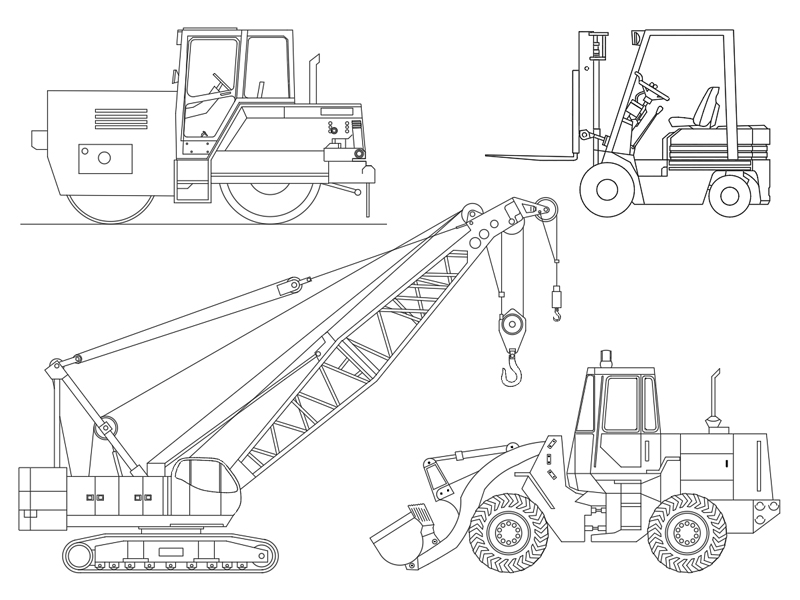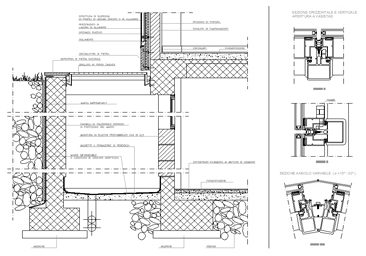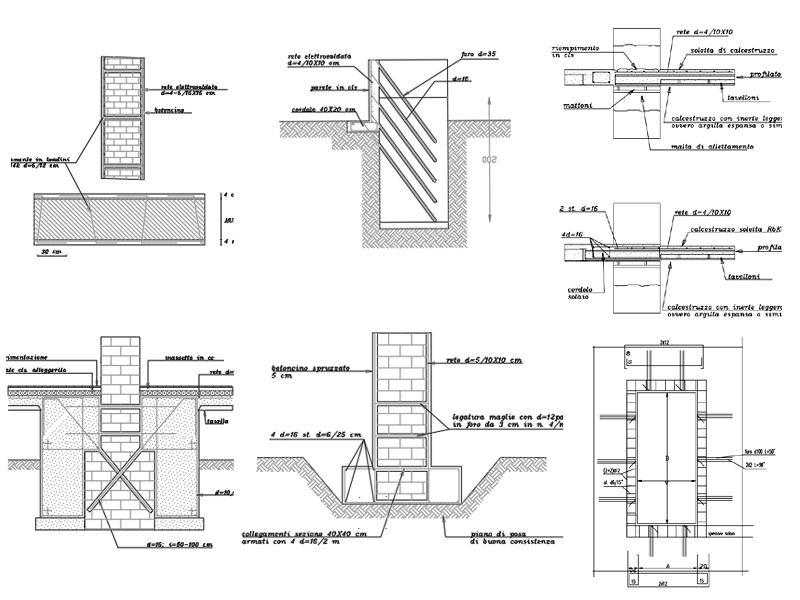Risk of collapse of the Garisenda Tower
Structure analysis - Monitoring system - Safety solutions
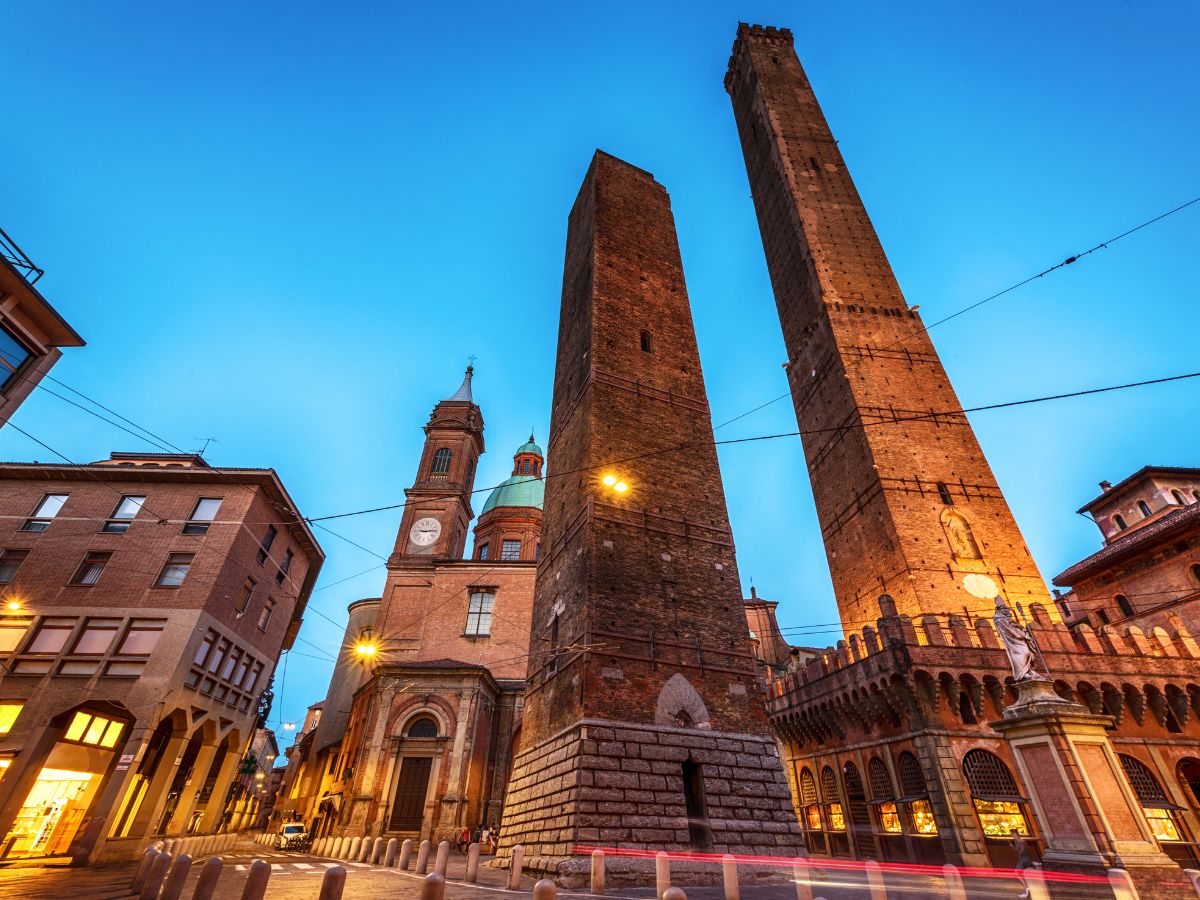
The Garisenda Tower is one of the most iconic symbols of the city of Bologna. Located in the heart of the historic center, it has witnessed centuries of history and has fascinated visitors and scholars from all over the world. This medieval tower, 48 meters high, is known for its inclination, which has made it a unique landmark in the Italian architectural panorama. Built in the 12th century, the Tower is now of concern due to the conditions of potential collapse in which it finds itself.
Below, we will analyze the structure of the Garisenda Tower, the activities of the Technical-Scientific Committees (CTS) for Conservation and the monitoring system adopted. Furthermore, we will report the suitable solutions and guidelines for the technical design of the necessary interventions, identified by the CTS.
Garisenda Tower in Bologna
The Garisenda Tower is a medieval tower located in Bologna. It is one of the two symbolic towers of the city, together with the Torre degli Asinelli (the taller of the two).
The Tower was built in the 12th century by the Garisendi, a rich banking family. In the past it reached 60 meters, but currently its height is 48 meters and it is inclined by 3.22 degrees, which makes it one of the most inclined towers in the world, after the Tower of Pisa (3.97 degrees).
The Garisenda was cited by Dante Alighieri in the Divine Comedy, in canto XXXI of the Inferno. Dante compares the tower to the fallen angel Lucifer, who is imprisoned at the bottom of Hell.
Due to its inclination and potential risk of collapse, the tower has been the subject of numerous restoration works over the years. The most recent works were carried out in 2019 and made it possible to stabilize the tower and prevent further collapses. However, recently further consolidation work was necessary to avoid the collapse of the structure.
Architecture and construction of the Garisenda Tower
The Garisenda Tower has a square section, built using bricks and local limestone. The tower originally reached a height of approximately 60 meters, but over the centuries it has been reduced due to the subsidence of the foundations and partial collapses that have occurred.
Despite its inclination, the Garisenda Tower was built in a robust and resistant way, exploiting innovative architectural techniques for its time. The inclination is due to the subsidence of the ground on which the tower rests.
Towards the end of the 19th century, the tower underwent a restoration which included the addition of a selenite ashlar base cladding.
Risk of collapse of the Garisenda Tower
In recent decades, concerns have emerged regarding the structural stability of the Garisenda Tower. Investigations and analyzes conducted by experts have revealed that the tower is subject to a number of factors that could increase the risk of collapse of the structure. The slope and erosion of the surrounding terrain have been identified as the main risk factors. The presence of cracks and the degradation of the construction materials due to water infiltration are further elements that contribute to the instability of the tower.
Analysis of the structural integrity of the Garisenda Tower
To evaluate the structural integrity of the Garisenda Tower, in-depth analyzes were conducted using modern techniques such as a monitoring system and static and dynamic load analysis. These analyzes confirmed concerns regarding the stability of the tower and revealed the need for urgent interventions to avoid collapse. Experts highlighted the need to strengthen the structure, repair cracks and constantly monitor the evolution of the surrounding terrain.
Monitoring, protection actions and subjects involved
The Garisenda Tower has been equipped with a constant monitoring system since the 1990s, thanks to the installation of various detection instruments which have improved over time following technological evolution.
2018
In 2018, the Municipality of Bologna conducted further investigations on the Garisenda Tower to better understand its structural conditions. The investigations revealed the presence of water infiltrations, which caused some points of the masonry to become damp.
To solve the problem, the Administration drew up a project which included:
- The waterproofing of the summit terrace
- The partial closure of the bridge holes
- The sealing of the mortar joints of the four facades
The project obtained the opinion of the Superintendence in December 2018 and the works were carried out in 2019.
2019
In 2019, the Municipality of Bologna appointed a Scientific Committee to support the consolidation interventions of the Garisenda Tower. The Committee proposed creating active belting of the tower base to block tilting phenomena.
In February 2019, the Committee approved the basement consolidation project in three phases:
- First phase: interventions on the base, divided into five sub-phases.
- Second phase: creation of metal braces.
- Third phase: definitive consolidation of the base trunk, with reinforcement and replacement of the stone elements, unstitch intervention on the walls and injections of mixtures.
The project was approved by the Superintendency in 2019 and concerns temporary interventions, i.e. some interventions of the first phase.
In December 2019, the municipal administration approved the project drawn up by engineer Dallavalle and entrusted the works to the CORMA consortium.
2020
In 2020, despite the pandemic, the consolidation works of the Garisenda Tower continue. Investigations and laboratory tests are carried out to evaluate the type of mortar to be injected and the impact of the foundations for the two protective metal elements.
In December 2020, the Administration approves the continuation of the intervention, which includes:
- Monitoring and verification of the state of the bag of the tower base
- Microinjections
- Passive confinement orthogonal to the walls
- Active confinement orthogonal to the walls
- Preliminary works for the definitive interventions
The works are started and the investigations necessary to understand the degradation of the materials that make up the so-called “bag” are carried out. Passive confinement orthogonal to the walls is achieved via a wooden structure around the tower, which is held in tension by metal belts.
2022
In October 2022, the suitable mortar for the microinjection works between the cracks of the tower is identified. The technical-scientific committee, which follows the work, addresses the issue of how to control the spread of injections and the effectiveness of this intervention.
Although the municipal administration approves the project for the microinjection and restillation works on the base of the tower and entrusts the work to a company, the construction site is suspended to allow a new and larger CTS to become aware of the contents of the project and to require the improvement of some aspects.
2023
In September 2023, the new committee approves an experimental intervention on just one side of the tower, to then extend it to the entire base in the event of a positive outcome. In the same session the structural engineers agreed on the need to continuously monitor the effects of the injections over time, establishing the tolerability thresholds of the intervention.
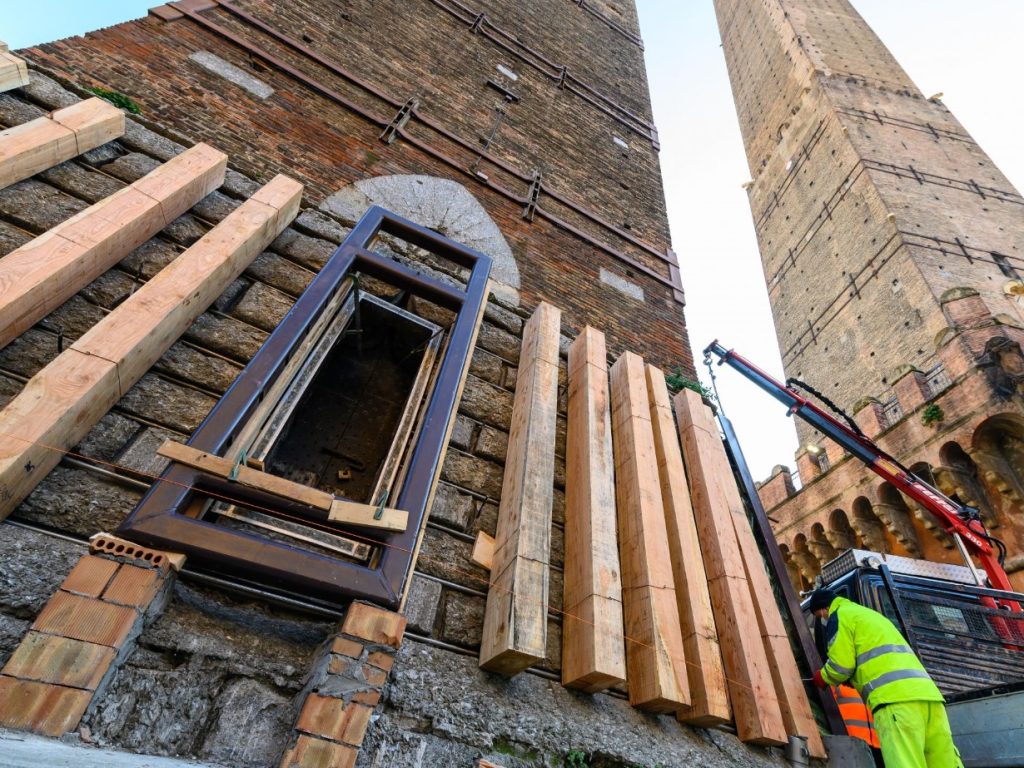
Engineering red alert
In July 2023, the CTS delivers a reading of monitoring data indicating crushing progress at the base of the Garisenda Tower, not only on the southeast side but also on the southwest side.
At the end of September, the CTS approves the microinjection and pilot pile projects, with a monitoring plan to report any alarms. From the data collected by the monitoring system it emerges that the Tower was developing a new trend of movement in a southerly direction, that is “an anomalous trend compared to the trend observed in past years, which was essentially towards the East”.
The CTS declares the situation to be on “engineering red alert” and blocks the work, pending further analysis.
To be precise, the engineering red alert is different from the civil protection red alert. The first indicates structural criticalities that must be monitored, the second indicates an imminent risk of collapse.
The CTS decides to proceed by implementing the pilot project and at the same time the system for developing the alarm thresholds.
CTS meeting of 4 October 2023
On 4 October 2023, a restricted meeting of the CTS took place, in which the data collected on the tower were presented and which confirm what was previously stated. That is, “the development of worrying residues in the deformations of the South West (SW) corner of the basement and the change in the historical movement trend of the pendulum.”
We report the conclusions of the meeting:
“After an in-depth discussion, the following conclusions were reached.
- The available factual elements, deriving from investigations and monitoring, continue to report a highly critical static situation of the tower, with a negative evolution, and which in engineering terms can now be defined as a “code red”.
- Consequently, the actions to be undertaken from now on can only be considered as civil protection.
- With this in mind, a meeting will be held with the Fagioli company to explore the possibility of creating a defense structure to support the tower in a very short time, with the aim of preventing a possible collapse or, in the extreme case, of controlling the mechanism of collapse to minimize all possible risks deriving from it. Only in the presence of an effective control will it be possible to proceed with other improvement interventions, but, at present, the activity which involved injections into the base bag is suspended.
- If this road is not practicable, it will be inevitable to activate the procedures envisaged by the civil protection plan, with the closure of Piazza Ravegnana and the clearing of the buildings at risk.”
Inspections October 2023
In October 2023, 3 inspections were carried out by some members of the CTS. The inspections had the aim of also photographically representing the reasons for alarm provided by the processing of the monitoring data.
From inspections carried out, the following emerged in the technical report:
- “As the already noted phenomenon of disintegration of the selenite at the base of the tower is still in the development phase and widely spread on the internal walls of the tower. The photographic image shown in Figure 9 as an example illustrates the condition of chemical disintegration/ physics of the selenite which constitutes the facing containing the so-called “bag” in conglomerate.
- How the vertical micro cracks in the bricks placed immediately above the selenite base, already detected in 2020 only on the South side of the South West corner of the tower (see Figure 4), have now spread widely also on the East and West sides (Figures 6, 7 and 8). It should be noted that these vertical micro cracks in the bricks (which often do not involve the mortar) are of particular importance and attention as they were identified by Professor Luigia Binda (Technical Consultant of the Pavia Prosecutor’s Office regarding the identification of the causes of the collapse of the Civic Tower occurred in 1989) as an indicator of the creep phenomena under static load that caused the collapse of the Civic Tower of Pavia. The photographic images shown illustrate only some of the numerous microcracks detected.”
CTS technical report dated November 15, 2023
On 20 October 2023, at the request of the Mayor Matteo Lepore, the Prefect calls a meeting of the Committee for Public Order and Security, to discuss the safety of the Garisenda tower.
During the meeting, Lepore announced that he would ask the CTS with the utmost urgency for a definitive and clarifying dossier on the data emerging from the surveys on the Tower. In particular, the mayor of Bologna requests that the technical report include:
- data analysis highlighting the coherence between the different measurement tools, the presence of any anomalies, in particular of the strain gauges;
- all the elements “to determine suitable solutions for the consolidation of the Garisenda tower” and “to provide guidelines, through written summaries for the technical design of the consolidation interventions” as envisaged in the tasks of the committee, approved by council resolution PG.395798/2023 on 6/06/2023.
- provide useful elements for an update of the Garisenda tower collapse simulation and the civil protection plan.
On November 15, 2023, the Scientific Technical Committee for the consolidation of the Garisenda Tower presents the technical report, with the following answers to the questions asked.
1. Data analysis highlighting the coherence between the different measurement tools, the presence of any anomalies, in particular of the strain gauges.
Based on the data that has emerged in recent years, the CTS presents the following conclusions:
“In the last period, the monitoring system has highlighted how the overall situation has unfortunately significantly worsened, with worrying implications in terms of the general stability of the tower, for the following main reasons:
- more than a year after the completion of the work to encircle the base, which should have created its effective confinement and therefore an improvement in the mechanical performance of the materials that compose it, the medium-term data do not allow us to detect any significant improvement in the trends prior to these interventions; on the contrary, the speed of deformations in the base (crushing under constant load) appears to have significantly increased;
- as clearly demonstrated by the pendulum surveys of the last period, the tower seems to have modified its thousand-year-old movement of the top towards the East / South-East, undertaking a new movement towards the South.
This unexpected and accelerated trend suggested to the CTS to immediately suspend any other activity in progress (in particular consolidation) and to bring attention to conditions of maximum alert, believing that the safety conditions no longer exist to operate on and near of the tower, if not as part of a civil protection plan.”
2. All the elements “to determine suitable solutions for the consolidation of the Garisenda Tower” and “to provide guidelines, through written summaries for the technical design of the consolidation interventions” as envisaged in the tasks of the committee, approved by council resolution pg. 395798/2023 dated 6/06/2023
“In the context outlined above, the Municipality of Bologna has adopted a civil protection plan, which includes, among the various scenarios, the possibility of sudden and unpredictable collapse. The definition and management of this plan goes beyond the tasks of the Scientific Technical Committee.
Once the civil protection plan has been defined, it is appropriate for the Municipality of Bologna to urgently entrust the safety of the tower and the surrounding areas to a specific specialized company.”
“Considering the critical nature of the situation and the objective difficulty in operating, in order to safeguard the safety of people and prevent the loss of the property, as well as the surrounding artefacts, the Committee suggests operating according to two levels of intervention, distinguished by timing and purpose:
- installation of protective barriers, an intervention that must be carried out in a very short time: these barriers must be positioned in such a way as to maximize the area in which the rubble can accumulate in the event of a collapse, so as to contain them even in the event that the collapse should occur with an overturning component; these barriers must have a height sufficient to contain the volume of the rubble, which is expected to be greater than the volume of the tower’s masonry, due to the voids that will remain in the rubble;
- implementation of temporary interventions, to be carried out as quickly as possible, with the function not only of confining any collapse but also, in a subsequent phase, of allowing consolidation and restoration interventions, also contemplating the possibility of partially relieving the load on the base.”
Further clarifications from the CTS:
- All of the above must obviously be achieved as quickly as possible.
- The temporary interventions to be carried out must be reversible and must be designed in such a way as to allow, once carried out, all possible and appropriate future interventions on the tower to be carried out.
- The CTS also recommends that these structures allow, or rather encourage, an overall examination of the building.
- In the event of having to cover part of the surfaces, we ask that you first acquire high definition and georeferenced images capable of providing a detailed survey.
- As regards future consolidation interventions, it is shown that they may also include those aimed at reducing the effects of the weight of the tower on the base and lower part of the tower.
3. Provide useful elements for updating the collapse simulation and the civil protection plan
“With regards to the subject of question 3, it should be noted that the identification of the areas at risk due to the possible collapse mechanisms of the tower is outside the tasks of the Scientific Technical Committee.
Here we can only limit ourselves to recalling the work carried out in 2020 (with subsequent update in 2021) by profs. Tomaso Trombetti and Angelo di Tommaso, who developed simulations to define the areas affected by potential collapse (implosion and/or overturning). These simulations require appropriate updates, also in light of the changed movement trends of the top of the tower.“
Securing the Garisenda Tower
At the end of November, work began to build the containment structure of the Garisenda Tower, which represents the first phase of the safety process. After the inspections to verify the underground services and the removal of the electrical cables that interfered with the affected area, carried out by the Municipality, the preliminary works began to position the containers and the metal mesh.
First phase: Containment belt of the Garisenda Tower
In the first days of December, the positioning of the containers and the first elements that will constitute the containment structure for the first safety phase began in Piazza di Porta Ravegnana.
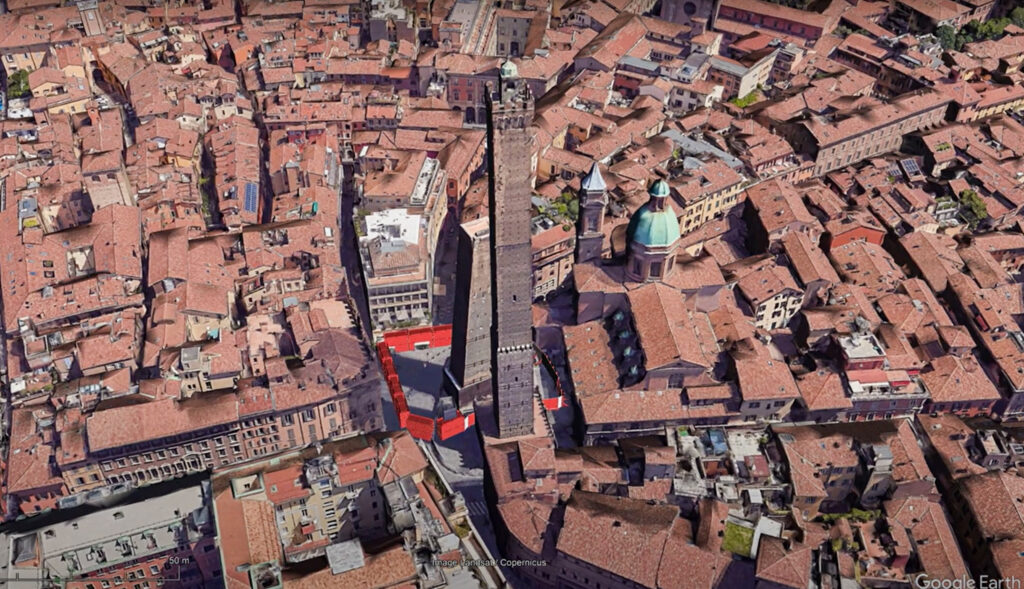
The contractor Fagioli will have to create a protective belt to contain debris in the event of a collapse, in order to reduce the vulnerability of the surrounding buildings and protect the population. This belt will prevent access to the limited area and will be made up of metal modules which will be anchored and ballasted to the ground. Furthermore, specially designed metal rockfall protection nets with pre-tensioning and ground anchoring systems will be used.
The creation of the protection belt will require an adequate logistical plan for the transport of materials and the pre-assembly of the modules at an Operational Hub located in via dell’Industria in Bologna, outside the historic center. This will make it possible to reduce construction activities in Piazza Porta Ravegnana to a minimum and minimize the impact on mobility. Thanks to this logistical solution, the transport of the structure can take place mainly with ordinary means, avoiding the use of exceptional means except in sporadic cases.
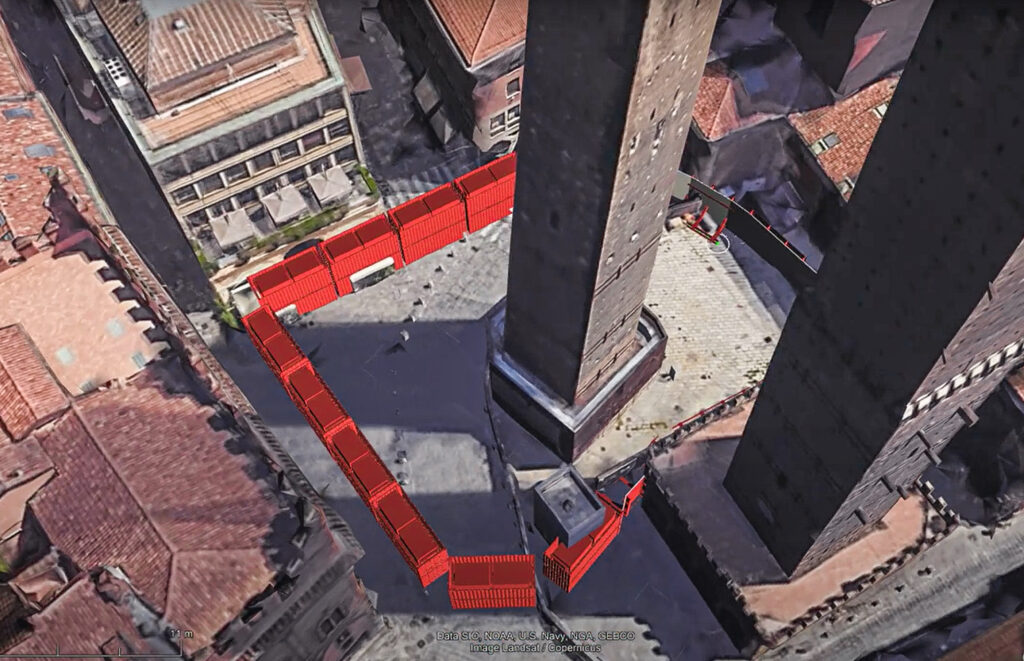
It is estimated that the construction site of the Garisenda protection belt will be completed by January-February 2024.
The economic framework indicated in the Council resolution amounts to just over 4.2 million euros.
Second phase: Cylinder around the Garisenda
The next phase to guarantee the safety of the Garisenda Tower will last at least six months. The mayor of Bologna, Matteo Lepore, explained this during a press conference. During this phase, a cylinder will be built around the Garisenda Tower, which will take significantly longer.
Third phase: restoration of the Garisenda Tower
The third phase, that of restoration, will take even more time, says Lepore. “We will discuss this later”, the mayor cuts short and adds “The time required for the first phase was very short”, implying that the restoration phase will also be defined soon.
Our photo gallery of the works, click on the image to view the photos in detail ▼
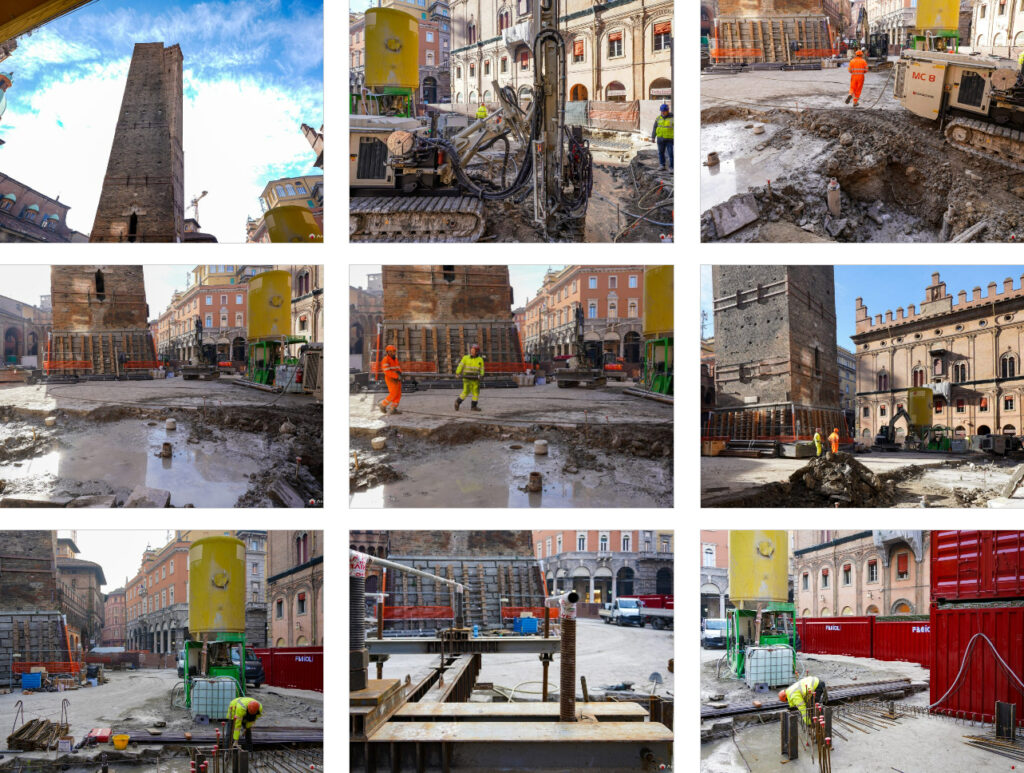
28 March 2024 – Mayor announces work to secure the Garisenda Tower
At a press conference in Palazzo d’Accursio, the mayor of Bologna, Matteo Lepore, announced the details of the Torre Garisenda’s safety work.
The modes of intervention
Lepore explained that the steel trusses already successfully used for the Leaning Tower of Pisa will be used to stabilise the tower. These trusses, suitably modified, will speed up the work and keep costs down.
Project phases
The intervention will take place in three stages:
- Installation of the pylons: within the perimeter of the red containers the two steel structures will pull the Garisenda to reduce the inclination and prevent a possible collapse. Reducing the angle of inclination will ensure the stability of the tower.
- Monitoring: the tower will be constantly monitored to assess the effectiveness of the intervention.
- Restoration: once the safety measures have been completed, the structural consolidation and subsequent conservative restoration of the tower will be carried out.
Timing
The aim is to complete the work by 2024. Once the pylons are installed, the tower will “come out of the yellow phase” and will be “secured, entering the green phase“, the mayor pointed out.
Mayor Lepore’s words:
“The Garisenda Tower is a symbol of Bologna and an important piece of our history”, said Mayor Lepore. “With this intervention, which uses an innovative technology already successfully tested in Pisa, we want to secure and save the Tower of Bologna.
Foto di copertina: Trifonov_Evgeniy da Getty Images






























































